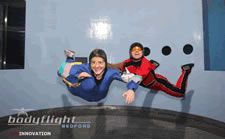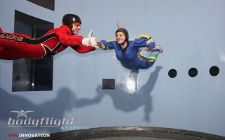
Robyn has a go at flying like Bond
On a gloomy industrial estate just outside Luton lies an unexpectedly exciting construction. The towering, grey, circular building appears to be an enormous chimney, a small gas accumulator or perhaps a purposefully nondescript location for a secret government activity. In reality, the third is perhaps closest to the truth. This structure was built in the 1950s by DERA (Defence Evaluation & Research Agency), a branch of the Ministry of Defence, to improve the aerodynamic qualities of high-speed planes. It is the largest and fastest vertical wind tunnel in the world.
In 2001, amateur skydiver Paul Mayer visited a wind tunnel in Florida to improve his freefalling skills. It wasn’t unheard of in the UK – Bedford had also been used in the late 90s by the British Parachute Institute and operated under a simple premise: blow enough wind at something, and it’ll take off. Returning home to England, Mayer set out to resurrect the Bedford wind tunnel which had been demilitarised in 1997 and fallen into disrepair. With the help of his business partner, Mike Maddock, an arrangement was made to open it up to the public. Instead of testing wings, propellers and ejector seats, they stuck in a person, made a few modifications, and Bodyflight was born.
The Bodyflight nerve centre is a circular room roughly two thirds of the way up the tower, the floor and the ceiling made of a wire mesh which allows the air to circulate without you careering off into outer space or crashing into one of the giant fans. At 26ft high and 16.5ft in diameter, it is a place where everyday folk can fly.
But how is it done? Simple, really: a couple of massive fans and a large cone in the base of the tower help to propel the air upwards at speeds of up to 170mph, allowing you to literally float – albeit not too serenely – on top of the rushing wind. It’s not the most glamorous way to fly, certainly; this is no Concorde, and in-flight snacks are not recommended.
 Participants are dressed in a neon jumpsuit and told to hold their bodies “in the shape of a banana”, before being given a few simple commands (“this means move your legs together, this means put your chin up”). The instructors are cheerful and not remotely patronising, keeping the explanation brief and friendly and appearing to genuinely enjoy their jobs; well, it is slightly more eventful than being an accountant. Starting up involves standing in the doorway and half-falling into the constant blast of air in the room itself Instructors, standing expertly whilst you flail around madly, help you up before you realise to your surprise that not a single part of your body is touching a surface. You are, by definition, flying.
Participants are dressed in a neon jumpsuit and told to hold their bodies “in the shape of a banana”, before being given a few simple commands (“this means move your legs together, this means put your chin up”). The instructors are cheerful and not remotely patronising, keeping the explanation brief and friendly and appearing to genuinely enjoy their jobs; well, it is slightly more eventful than being an accountant. Starting up involves standing in the doorway and half-falling into the constant blast of air in the room itself Instructors, standing expertly whilst you flail around madly, help you up before you realise to your surprise that not a single part of your body is touching a surface. You are, by definition, flying.
This outwardly unassuming spot was the recent location for the filming of one of the few memorable stunts in the latest James Bond film, Quantum Of Solace. Viewers (avid or otherwise) should recall the moment that James (Daniel Craig) and his girl of the moment, Camille (Olga Kurylenko) were forced to leap out of a plane as it plummeted towards the ground. They tumble around, grasp for the parachute, and deploy it about three seconds before hitting the rocky ground of a sink hole in the middle of the desert.
Expert parachutists will have looked on with a modicum of derision at the unlikely success of such a speedy parachute deployment, but even the unrealistic landing can’t cover up the remarkable shot of the pair zooming through the ether towards the ground. It was this moment that was filmed in a single day at the Bedford-based Bodyflight.
One day, yes, but “one looooong day” according to Jay Richardson, the instructor who served as bodyflying expert during the shoot. Jay was initially asked to provide tips on how to improve the durability of Bond’s suit. When it was first tested in the buffeting winds of the tunnel, it was quickly ripped to shreds and it needed Jay’s expert eye to point out particularly vulnerable areas for the next attempt.
When the reinforced suit arrived, the director Marc Forster sized up his adviser and assessed Jay to be “about Daniel’s size” before asking him to try it on and testing it with all of his best moves. The improvements appeared to have worked and Jay was only too happy to give it a go (“It was Tom Ford. It was a nice suit”). In fact, Forster was so impressed with his bodyflying abilities that, when Craig’s body double was unable to participate, the spot was quickly offered to Jay.
Bodyflight is the location for World Challenge, the international bodyflying championships. It also still assists its original instigators, offering opportunities for members of the armed forces to practice their freefalling techniques without the taxpayer having to fund a plane journey each time.
There’s a viewing platform next to the flight chamber from which you can watch the current participants whizz around with expert agility before having a go yourself, possibly not with as much coordination but certainly with no less enthusiasm. Play your cards right and you might even catch the British formation team having a quick choreographed practice. Ordinary people who physically can’t or simply don’t wish to jump out of a plane can experience the sensation of freefall without the fear of tumbling to Earth post-parachute failure. Meanwhile, they’re rubbing shoulders with professionals and experts, both skydivers and full-time bodyfliers, getting just as much use and excitement from the tunnel as their amateur contemporaries.
The staff once fitted 26 people into the tunnel at the same time. Why? Just because they could! It’s like the bloke on that blind date you finally agreed to; unassuming and not particularly attractive, but nonetheless full of possibility.
It took two days to prep the area and train the cast and crew to be able to film in the conditions of the wind tunnel. The entire thing had to be painted white, most of the windows taken out, and those that remained painted white to match the walls. The cast and crew were then given a crash course (ho ho) in bodyflying, and a host of camera gear was set up in and around the room itself, setting a world record for the largest amount of digital equipment used in a single scene.
As well as the camera poking through the windows on the wall, an additional cameraman was also inside the flight chamber itself along with the two actors or stuntmen, supported by Bodyflight instructors. Participants in bodyflying are usually required to wear plastic goggles – not dissimilar to the type used during actual skydiving – but Craig and Kurylenko were given special wind-resistant contact lenses instead.
Bedford has previously played host to Blue Peter and smaller films, but Quantum Of Solace is the first major feature film to incorporate bodyflying as a substitute for freefalling. One may be forgiven for wondering why. With a final effect far more realistic than blowing a fan in the actors’ faces, and easier to attain than getting insurance for dropping a megastar to earth from 15,000ft, it’s probable that we will see Bodyflight-based skydiving sequences appearing more regularly now that 007 has demonstrated their potential. Since the air speed can be adjusted minutely according to the number and weight of the participants, a variety of stunts and effects can be achieved. And with experts like Jay and his colleagues strutting their stuff with enviably slick ability, the possibility for jaw-dropping stunts is endless.
Of course, for regular punters, the best thing about Bodyflight is that it enables us, for a few minutes at least, to experience not only the joy of skydiving but also the short-lived belief that we are in a James Bond movie. There are no doubt easier and cheaper ways to pretend to be the man himself. But as much fun as ground-based Bond impersonations may be, there’s no doubt that two and a half minutes at Bodyflight is considerably more exciting than ordering a badly-mixed martini in your local pub and leering “Yesh, Moneypenny” at every passing girl.
Here you can fly through the air for real, without the need to imbibe illegal substances. Here you can encounter the sensation of freefall without paying several thousand pounds to do it solo or having a burly instructor strapped to your back. (In retrospect, this could perhaps be a downside... although if you’re lucky, you’ll get Jay floating around and grabbing you to demonstrate a point. He was Daniel Craig’s stunt double, after all, so let’s face it, girls – it could be worse).
All right, so I looked less like a golden eagle and more like Eddie the Eagle. And yes, a metal mesh and some flashing blue lights don’t quite match up to vistas of mountains, beaches, rolling hills and other skydiving-based locations. But there’s more opportunity for manoeuvres, no chafing harness to restrict your movements, and a significantly lower chance of death. And it’s a whole lot cheaper, too.
Two years ago, Jay was a courier before a chance visit to Bodyflight piqued his interest and caused him to jack in the day job and take up instructing on a full-time basis. One minute he was delivering packages... the next, wearing Tom Ford suits, flying for a living, attending London film premiers and rubbing shoulders with international A-listers. Situated on a miserable industrial estate his current profession may be, but would Jay go back to couriering? “Not in a million years!” he says. Too right, says I.
Have you got any job openings, Bodyflight?





















